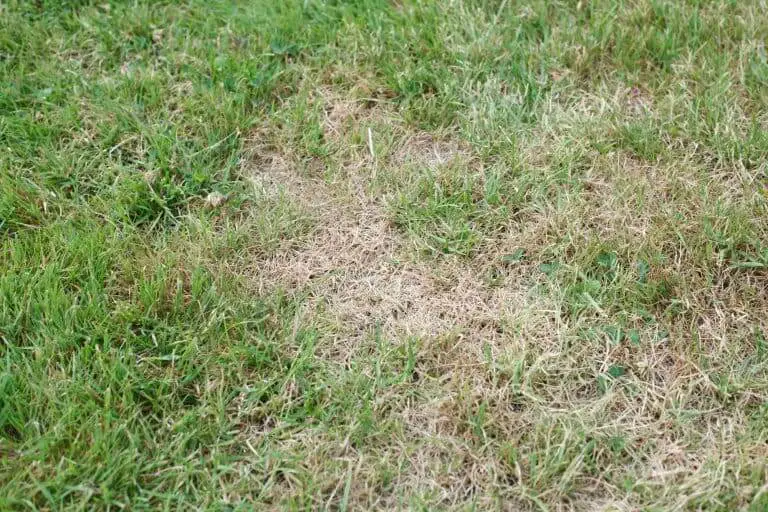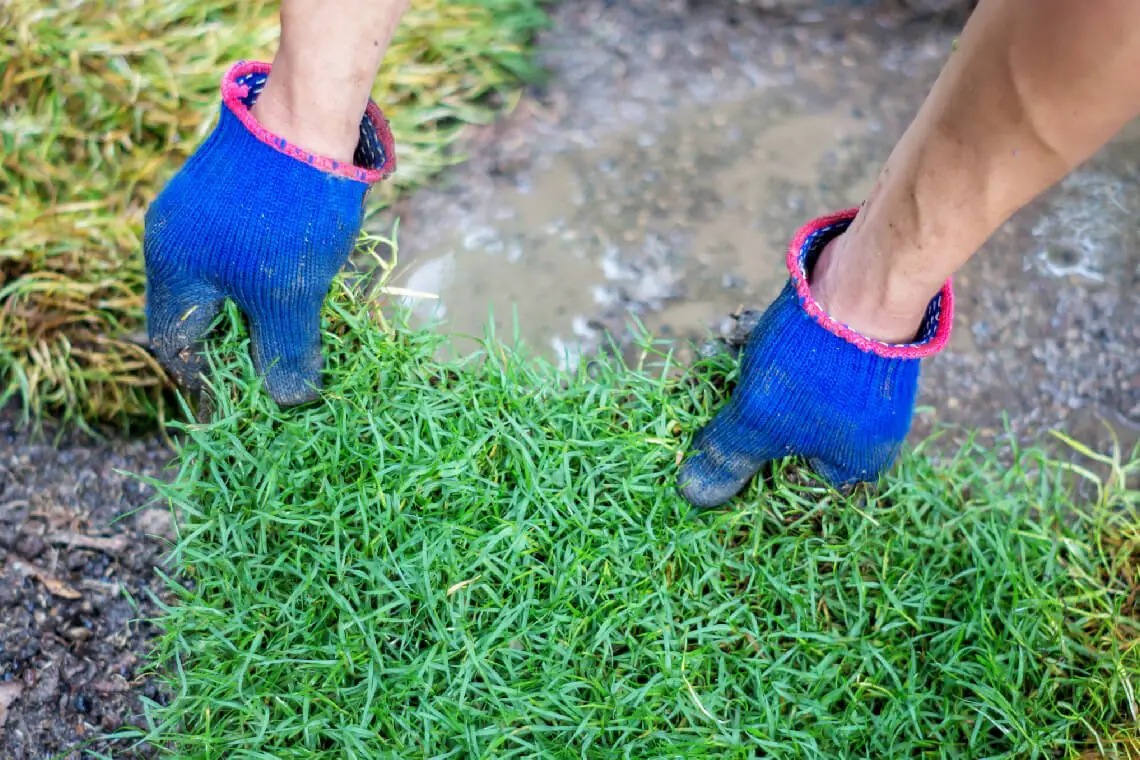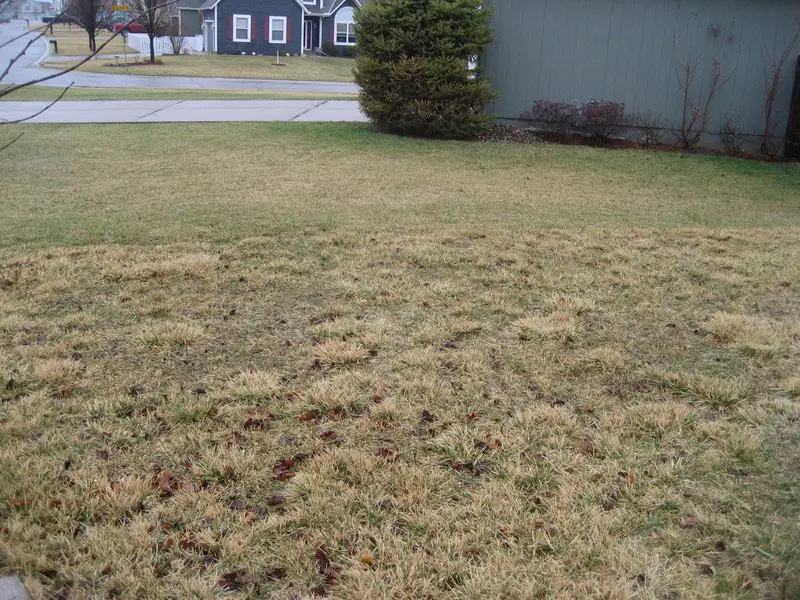Tips To Keep Your Lawn Healthy
After youve gone through the trouble and expense of reviving your dead lawn, the last thing you want is for it to fall back into less than prime conditions. This is where good aftercare comes into play and can mean the difference in a thick, green flourishing lawn and one containing dead areas and in need of reviving.
Fixing Dog Spots On Grass
Anyone with a pet dog knows that all the love and attention they provide comes at cost dog spots on the lawn. They are most apparent after the snow melts each spring but they continue to turn up all summer long. Dog spots are round patches usually 4 to 8 inches in diameter but can appear larger when several spots join together. The center of the spot is yellow dead grass surrounded by a ring of dark green grass.
Fungal Or Brown Patch Disease
If youre noticing brown patches on your lawn, one obvious culprit could be brown patch disease. While the name sounds like a broad description of a symptom, brown patch disease is actually a specific type of fungal infection. Other fungal infections can also cause brown, dead patches in your lawn. If youre facing a fungal disease in your lawn, you will need to treat it with the right fungicide for your disease. To do that, you need to know what disease you are treating. Well talk more about testing for disease later.
You May Like: How To Change Oil In Craftsman Lawn Mower
Overwintering For A Beautiful Spring Lawn
Our main goal during the winter is to keep your lawn from drying out. Early fall is the perfect time to take action to make sure your winter lawn gets a healthy rest and comes back green and gorgeous in spring. Aeration and topdressing are two of the best techniques for keeping lawns healthy all winter long.
Core aeration involves putting small holes in the lawn to let water and nutrients get to the roots. We use a special machine to make the process fast and efficient.
Topdressing is a nutrient-rich sand or soil mix that we spread in a thin layer on your lawn. It has several benefits as we head into winter: it encourages decomposition and reduces thatch buildup and prevents the lawn from drying out. If we opt for core aeration, adding a topdressing treatment helps with recovery by filtering nutrients into the holes.
Identifying Necrotic Ring Spots

In general, if you have a necrotic ring spot youll be looking at a horse shoe/circular pattern about four to twelve inches in diameter. These grass spots have a light brown shade surrounded by green center.
Grass with ring spot disease has a very thin root system, so its not very resilient. These areas may arise in a smaller section of your lawn before spreading out over a number of years.
They tend to attack the same areas of your lawn each season. The patterns tend to look similar each year, although if you dont treat this problem, the size of the rings will get bigger and bigger!
The fungus spreads out by spores and mycelia.
You May Like: Does Peat Moss Help Grass Grow
How To Fix Dead Grass Is It Dead Or Dormant
Whether youve had an intensely hot summer, left on vacation for a few weeks, or had a pet leave spots on your lawn, nobody likes to see yellowed or brown killed grass on their lawn. Your homes curb appeal can tell a story to guests and neighbors, so its important to keep your lawn in high standing as much as possible.
When exposed to extreme heat, extended cold, or minimal water over a period of time, grass begins to dry, recede, and eventually die if proper growing conditions arent restored.
This dormancy happens because the grass is trying to preserve itself with limited resources, so it focuses on maintaining the rooting rather than the surface grass. Fortunately, before total death there is a period of dormancy where your lawn is just waiting to come back to life with proper treatment.
If your grass is actually dead, then here is the basic process to fix it:
- Begin a new lawn by raking the dead grass up so that youre left with just the soil.
- Spread seed so that they land firmly in the soil you tilled.
- Apply natural or chemical fertilizer to get it off on the right foot, and water & mulch it with healthy grass clippings or leaves for additional nutrients.
- Maintain it with proper sunlight & water so that it can grow. It may be a bit uneven to start, but give it a few weeks before you add another layer of seeds spots that havent grown.
But, is your grass dead or is it dormant? Lets find out read on!
In This Article:
Some Signs Of Nrs Fungus
- Brown spots that feel like healthy grass
- Ring-shaped brown spots which may appear light-green in spring
- Ring-shaped depressions in the soil
- The grass is easy to pull up
- Fungal hyphae visible on roots
You might consider contacting a Utah State University Extension Agent or IFA Country Store specialist to help diagnose the problem.
Recommended Reading: What Is The Smallest Riding Lawn Mower
How To Repair A Lawn & Seed Bare Patches
Water’s only part of what you need to fix those dead spots in your lawn and keep them from coming back.
Bald. Bare. Thin. Whatever you call it, one thing is certain: Patchy lawns stink. Until automatic, self-repairing lawns are invented, we’ve got the next best thing quick and easy bare spot repair. Read on for the simple how-to, plus a few extras for keeping your lawn looking lush even longer.
Can I Replace Dead Grass With New Sod
If you have multiple dead patches or a large area of dead grass, new sod may be the best option. We can replace or patch your lawn with a lush green sod roll. If well cared for, the new sod will soon blend right in with your existing turf. Sodding gives you immediate results but tends to be more expensive than reseeding. However, it may be the way to go if you have more extensive summer lawn damage
Recommended Reading: Revive Organic Soil Treatment Reviews
Why Does Dog Urine Damage Grass
Let us start by addressing the root of the problem. Most dogs go outside to use the bathroom, but over time, dog urine can damage the grass, leaving it discolored and bare in areas with a high urine concentration.
But, why does this happen?
The answer is that dog urine contains a high level of nitrogen and salts, which can cause nutrient burn on your grass. Nitrogen is a beneficial macronutrient for plants, but too much of it can lead to stunted growth or dead grass.
Nitrogen builds up as a dog naturally breaks down protein. Since most dogs have a high protein diet, this becomes a problem for the grass. If your canine companion has a preferred area where they like to pee, the frequent and high urine exposure in a concentrated area can lead to fertilizer burn.
It is important to note that both female and male dogs have the same likelihood of damaging lawns with their urine. Contrary to popular belief, female dogs do not have different urine that causes the burn.
Damaged spots usually occur when urine is concentrated in a puddle. Dogs that squat to urinate, including females, puppies, and elderly dogs have a higher risk of burning the grass since the urine is concentrated in a single area.
A majority of male dogs urinate by lifting one leg to mark their territory with spurts of urine that tend to spread across an area, thereby, spreading the damage without creating an unseemly discolored or bare spot, but scattered specks that are harder to notice at first.
Maintain A Healthy Lawn
The healthier your lawn is to begin with, the easier it will be to prevent brown patches. Take care of your grass by giving it the nutrients and protection it needs to flourish year-round this includes consistent watering, mowing, fertilizing, and weed control.
If youre busy with a job, a family, and a house to take care of, it may be in your best interest to hire a professional local lawn care company to take care of it for you throughout the entire year.
Read Also: How To Kill Creeping Charlie In Lawn
The Wrong Type Of Turf
There are many different turfgrass types, and not every variety is suited for every climate and soil type. If you plant a turfy type that is incompatible with your weather or landscape, it may not last.
The first factor to check is whether your turf grass variety is recommended for your climate zone. In general, the US is divided into three growing zones for turfgrass. The northern half of the country is considered a cool-season zone and requires cool-season grass. The Southwest and Deep South are considered a warm-season zone and require warm-season varieties. The area between is regarded as a transitional zone, and lawns can be planted with either type of grass, or a combination to withstand both hot and cold temperatures. If you grow a variety of grass that is not suited for your climate, you may find your grass dying during the season it is least well-adjusted to.
Turf varieties also vary in how they handle different growing conditions. While no turf can thrive in full shade, some varieties can tolerate partial shade better than others. One of the most shade-tolerant varieties of warm-season grass is Zeon Zoysiagrass, sold exclusively by The Turfgrass Group. For lawns with trees and partial shade, Zeon Zoysiagrass will grow better than other sun-loving varieties.
Fixing Small Sections Of The Lawn

Its ideal to start from repairing small sections of the yard when fixing patchy grass in your lawn. Consider getting a seed patch and repair product. First, loosen the soil by raking the ground, apply the seed and water daily. Although new seed needs more frequent watering, theres a need to exercise caution to avoid overwatering, to prevent the new seeds from drowning. Patch and repair products usually come with mulch, which helps the soil retain water, keep the seeds moist enough, and improve germination speed.
Don’t Miss: Estimates For Lawn Care
Pests Below The Surface
Grubs are a kind of early-stage larvae beetle that eats grassroots, which leaves only the tops of the blades to stand with no foundation. Your lawn can tolerate a small amount of them, but a large concentration can cause dead spots to develop.
Youll know grubs are the problem if the dead patch easily lifts from the ground when you give it a gentle tug.
How to Prevent It
You cantreat the infestation with nematodes or with an insecticide. You can then resod to help bring back the dead areas of grass to life.
Treating for this is best done during autumn months, as this is when grubs are smaller and are most susceptible to nematodes.
Over Use Of Chemical Fertilizers And Pesticides
While some of these products can be beneficial to your lawn, applying too much of them can actually contribute to the problem.
Many of the fertilizers available today contain high concentrations of salt like urea and nitrates. These are cheaper per pound of nitrogen, but they also kill the microorganisms in the soil.
Also Check: How To Estimate Lawn Mowing Jobs
How To Repair Brown Spots From Dog Urine
Brown spots from dog urine are caused by the high levels of nitrogen and salts scorching the grasses. These dead and decaying areas, over time, stop growing, especially if they were already unhealthy, stressed, and susceptible to nutrient burn.
If you already have brown spots on your hands, we recommend watering the brown area frequently and deeply to flush the urine salts from the soil nearby.
While dead grass spots cannot be revived, there are ways to completely repair that damaged area. Keep in mind, the sooner you tackle brown spots, the better chance your grass has of recovering from the excess nitrogen and salts.
Here are the tools you will need for fixing dog urine spots:
- Rake or garden claw
- Mulch
Here are step-by-step instructions on how to treat urine spots on lawns.
} in stock in }
Limited stock in }Check nearby stores
Out of stock in }Check nearby stores
Not carried in}Check nearby stores
Cannot be sold in }Check nearby stores
} in stock in }
Grubs Or Other Pests Below The Turf
Grubs are the larvae of various hard-shelled beetles, such as the Japanese beetle or June bug. A lawn can tolerate some degree of grub infestation, but if the concentration is high, dead patches will appear in your lawn. A strong sign that you are dealing with grubs is if the dead patch lifts away from the ground easily when you tug on the grass. Grubs eat the roots of grass and leave nothing to hold the grass in place. Addressing this problem involves reseeding or resodding and preferably after you have dealt with the grub infestation.
The Spruce / K. Dave
You May Like: Permethrin For Ticks In Yard
How To Plant Grass Seed In Bare Spots
Perhaps you are already familiar with how to seed your lawn. However, reseeding dead spots in a lawn calls for added attention to detail. We have outlined the steps on how to plant grass seed in bare spots for your next lawn repair.
- Remove Debris
Before you start seeding the brown patch, remove any leaves or debris from the area to avoid damage. This removes any obstacles in distributing the seeds evenly among the dead grass. If the brown patch in your lawn was caused by urine or chemical spills, thoroughly rinse the area several times before reseeding to dilute any harmful chemicals.
- Break up the Soil
Refresh the soil of the brown patch by taking a rake or a garden cultivator to till the ground in your summer yard. This will help ensure that the soil is loose and ready to take in the new seed.
- Add Compost
Using compost is a great way to add nutrients back into the soil. Add a 2 to 3-inch layer of compost or loamy soil and use the rake again to mix it with the existing soil.
- Even out the Surface
Use the top of the rake to make a flat and even surface to start sprinkling the grass seed.
Evenly distribute a thin layer of grass seed over your brown patch.
- Protect the Seeds
If you choose to sprinkle the seed on top without pre-mixing it in the soil, place a thin layer of straw over the area to prevent birds from eating the seeds. Once the grass starts to bud, remove the straw.
- Keep the Area Lightly Watered
- Lightly Fertilize
- Wait to Mow
- Monitor the Area
Do Care For Repaired Areas Properly
Getting on the right watering schedule for your repaired areas as well as implementing an after-care program will be important steps when it comes to how to turn brown grass green.
Youve gone through the trouble of having your lawn properly repaired, now you want to make sure that it remains an effective solution. New grass can require some extra care in order to grow successfully.
You May Like: Best Lawn Chairs Ever
How To Repair Dog Holes And Other Lawn Damage
Dogs, especially puppies, have a lot of energy that they often devote to digging. They may dig for entertainment, to try and escape, or to hunt prey such as moles.3 It can take some time to train your dog to stop digging once they develop the habit, so intervene earlywith attention, training and praiseto stop digging problems right away.
Step in with quick lawn repairs to fix digging holes as soon as they appear:
For other lawn areas hit with doggy damage, turn to Pennington Lawn Booster. This all-in-one product combines premium Pennington Smart Seed, professional-grade fertilizer and soil enhancer. It’s guaranteed to grow quicker, thicker, greener grass in just one application.
Pennington, One Step Complete and Smart Seed are registered trademarks of Pennington Seed, Inc.
Foot Traffic Or Furniture

High wear can make it hard for your grass to grow. If your family and pets often tread the same route through your hard, this consistent traffic may create dead patches.
Leaving patio furniture, toys, or anything else on your grass for even a weekend can block sunlight and water from reaching the roots of your grass, causing dead spots. Almost anything, if left for long enough, can damage grass tarps, kiddie pools, chairs, or cars can leave behind a brown patch in their wake.
How to Prevent it
Reroute where your family and pets walk to give your grass a break. Also consider installing a stone, gravel, or mulch path where your family walks frequently.
To help grass under a trampoline stay healthy, one trick is to put a sprinkler underneath it whenever its not in use to make sure it still gets water. If youre going to put out a temporary pool, put it over a tarp first and try to move it around the yard throughout the summer so no one area gets too much damage.
Also Check: How Much Peat Moss For Lawn
